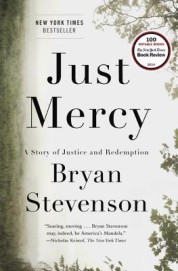 Bryan Stevenson
Bryan Stevenson
Spiegel & Grau ($16)
by George Longenecker
Bryan Stevenson has been on the front lines of social justice, as an attorney representing some of the neediest prisoners in the nation and as executive director of the Equal Justice Initiative. Just Mercy is a compelling narrative on the themes of economic and racial bias. Using stories of his clients, he paints pictures of human beings on the margins of the U.S. legal system.
Henry was the first death row prisoner Stevenson met: “He was a young, neatly-groomed African American man with short hair . . . wearing bright, clean prison whites. He looked immediately familiar to me, like everyone I grew up with.” Stevenson began his visits to Georgia’s death row afraid of what he’d find; he left calmed by Henry’s appreciation and determined to do more to help him. “I finished my internship committed to helping the death row prisoners I had met that month . . . I went back to law school with an intense desire to understand the laws and doctrines that sanctioned the death penalty and extreme punishments.”
Stevenson says that he could identify with his clients because of his upbringing “in a poor, rural, racially segregated settlement on the eastern shore of . . . Delaware where the racial history of this country casts a long shadow.” Like the prisoners he represents, the people he grew up with were “marginalized and excluded.”
It is the marginalized and excluded that Stevenson focuses on in this book, and their stories are compelling. Some are on death row; others were sentenced to adult prisons as children and have served decades for crimes that would have warranted juvenile adjudication and probation in some states. Trina Garnett, for example, was sentenced to life without parole in Pennsylvania after she unintentionally started a fire that killed two boys. She turned fifty-two last year and has been in prison for thirty-eight years. Ian Manuel was a thirteen-year-old neglected child when he shot and wounded Debbie Baigre during a bungled robbery in Florida. He too received life without parole; when he arrived at the Apalachee Correctional Institution, the guards could not find a uniform small enough to fit him. Despite his victim’s plea for a reduced sentence after he spent eighteen years in solitary confinement, Ian received no mercy from the courts. Florida has sentenced more than 100 children to life without parole for non-homicide offenses, most of them black or Latino.
Stevenson tells these stories with skill and compassion. He goes on to remind the reader that when an innocent person is wrongly convicted, the real perpetrator goes free. Through his legal successes and failures, Stevenson has maintained his faith and determination. He speaks eloquently of the ineffectiveness and injustice of executions and child incarceration and gives faces to the castaways of American jurisprudence in a narrative interspersed with legal history and calls for reform.

